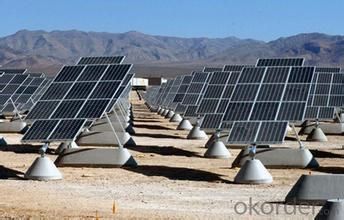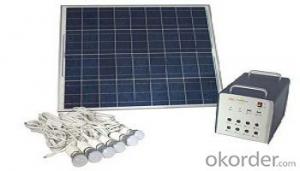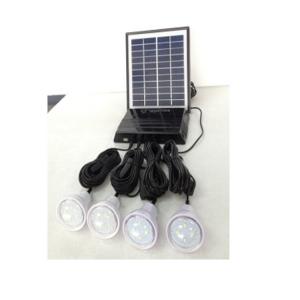Solar Energy Systems Quotes:CNBM On Grid System 800W with Certificate UL TUV CE
- Loading Port:
- Shanghai
- Payment Terms:
- TT OR LC
- Min Order Qty:
- 100 watt
- Supply Capability:
- 1000 watt/month
OKorder Service Pledge
OKorder Financial Service
You Might Also Like
Specification
CNBM On Grid System 800W with Certificate UL TUV CE
Product description
They range from small residential and commercial rooftop systems to large utility-scale solar power stations. Unlike stand-alone power systems, a grid-connected system rarely includes an integrated battery solution, as they are still very expensive. When conditions are right, the grid-connected PV system supplies the excess power, beyond consumption by the connected load, to the utility grid.
Connection of the photovoltaic power system can be done only through an interconnection agreement between the consumer and the utility company. The agreement details the various safety standards to be followed during the connection.[4]
Solar energy gathered by photovoltaic solar panels, intended for delivery to a power grid, must be conditioned, or processed for use, by a grid-connected inverter. Fundamentally, an inverter changes the DC input voltage from the PV to AC voltage for the grid. This inverter sits between the solar array and the grid, draws energy from each, and may be a large stand-alone unit or may be a collection of small inverters, each physically attached to individual solar panels. See AC Module. The inverter must monitor grid voltage, waveform, and frequency. One reason for monitoring is if the grid is dead or strays too far out of its nominal specifications, the inverter must not pass along any solar energy. An inverter connected to a malfunctioning power line will automatically disconnect in accordance with safety rules, for example UL1741, which vary by jurisdiction. Another reason for the inverter monitoring the grid is because for normal operation the inverter must synchronize with the grid waveform, and produce a voltage slightly higher than the grid itself, in order for energy to smoothly flow outward from the solar array.

Application
Industrial
Commercial
Residential
Feature
Residential, grid-connected rooftop systems which have a capacity more than 10 kilowatts can meet the load of most consumers.[2] They can feed excess power to the grid where it is consumed by other users. The feedback is done through a meter to monitor power transferred. Photovoltaic wattage may be less than average consumption, in which case the consumer will continue to purchase grid energy, but a lesser amount than previously. If photovoltaic wattage substantially exceeds average consumption, the energy produced by the panels will be much in excess of the demand. In this case, the excess power can yield revenue by selling it to the grid. Depending on their agreement with their local grid energy company, the consumer only needs to pay the cost of electricity consumed less the value of electricity generated. This will be a negative number if more electricity is generated than consumed.[3] Additionally, in some cases, cash incentives are paid from the grid operator to the consumer.
Packaging
With carton and box
- Q: Are solar energy systems suitable for residential properties?
- Yes, solar energy systems are suitable for residential properties. They can efficiently generate electricity and provide homeowners with a clean and renewable energy source. Additionally, solar panels can be installed on rooftops, maximizing space utilization. With advancements in technology, solar energy systems have become more affordable, making them a viable option for residential properties.
- Q: Are there any government incentives or tax credits for installing solar energy systems?
- Yes, there are government incentives and tax credits available for installing solar energy systems. These incentives vary by country and region, but common examples include federal tax credits, grants, rebates, and feed-in tariffs. These incentives aim to promote the adoption of renewable energy sources, reduce greenhouse gas emissions, and stimulate economic growth in the solar industry. It is advisable to research and consult local government agencies or professional advisors to determine the specific incentives and credits available in your area.
- Q: How do solar energy systems affect carbon footprint?
- Solar energy systems can significantly reduce carbon footprint as they generate electricity without burning fossil fuels. By harnessing the power of the sun, solar energy systems produce clean, renewable energy, thereby reducing greenhouse gas emissions and mitigating climate change. By switching to solar, we can decrease our reliance on carbon-intensive energy sources and help create a more sustainable and eco-friendly future.
- Q: Are there any risks of electrical surges or voltage fluctuations with solar energy systems?
- Yes, there are potential risks of electrical surges or voltage fluctuations with solar energy systems. While solar panels themselves do not generate surges or fluctuations, the integration of solar energy systems with the existing electrical grid can create certain challenges. One risk is that sudden changes in sunlight intensity can result in voltage fluctuations. For example, when a cloud passes over a solar panel, the sudden decrease in sunlight can cause a drop in voltage output. Similarly, when the cloud passes, the sudden increase in sunlight can cause a surge in voltage output. These fluctuations can potentially affect the stability of the electrical grid. Another risk is related to the inverters used in solar energy systems. Inverters convert the direct current (DC) produced by solar panels into alternating current (AC), which is compatible with the electrical grid. Inverter failure or malfunction can lead to voltage fluctuations or surges, which can damage electrical equipment or disrupt the electrical supply. To mitigate these risks, solar energy systems are usually equipped with protective devices like surge protectors and voltage stabilizers. Surge protectors help prevent voltage spikes by diverting excess energy away from the system, while voltage stabilizers regulate voltage levels to ensure a steady and safe supply of electricity. Moreover, proper installation and regular maintenance of solar energy systems are crucial to minimize the risks of electrical surges or voltage fluctuations. Qualified professionals should handle the installation process, ensuring that all components are correctly connected and grounded. Routine inspections and maintenance checks can help identify and address any issues before they escalate into serious problems. Overall, while solar energy systems offer numerous benefits, it is important to be aware of and address the potential risks associated with electrical surges or voltage fluctuations. By implementing appropriate protective devices, following proper installation and maintenance procedures, and working with qualified professionals, these risks can be effectively managed, ensuring the safe and reliable operation of solar energy systems.
- Q: How do solar energy systems affect the reliability of the electrical grid?
- The electrical grid's reliability can be influenced both positively and negatively by solar energy systems. On the positive side, these systems can assist in diversifying the sources of energy used for generating electricity, ultimately reducing reliance on traditional fossil fuels. This diversification has the potential to enhance the overall stability and reliability of the electrical grid. Moreover, solar energy systems can aid in decreasing the demand peak on the grid. When solar panels are most productive during daylight hours, they generate electricity that can be directly utilized by nearby buildings or fed back into the grid. This helps alleviate stress on the grid during periods of high demand, subsequently reducing the likelihood of power outages or blackouts. However, solar energy systems do present challenges to grid reliability. One of the primary concerns is the intermittent nature of solar power generation. Solar panels only produce electricity when the sun is shining, which means that their output is subject to variations caused by weather conditions and the time of day. This intermittency makes it difficult to match supply with demand, especially during cloudy or nighttime hours, resulting in potential imbalances or fluctuations in the grid. To tackle this issue, grid operators must carefully manage the integration of solar energy systems into the electrical grid. This involves using advanced forecasting and monitoring technologies to accurately predict solar power generation and plan for any potential fluctuations. Additionally, energy storage systems, such as batteries, can be deployed to store excess solar energy during periods of high generation and release it during times of low generation, thereby smoothing out the intermittent nature of solar power. Overall, although solar energy systems bring numerous benefits to the electrical grid, such as diversifying energy sources and reducing peak demand, they also present challenges related to intermittency. By embracing advanced technologies and implementing effective grid management strategies, these challenges can be mitigated, ultimately ensuring a reliable and resilient electrical grid.
- Q: What is the impact of tree shade on the performance of solar panels?
- The performance of solar panels can be greatly affected by the presence of tree shade. When trees cast shadows on solar panels, their ability to convert sunlight into electricity is significantly diminished. This occurs because the shade prevents direct sunlight from reaching the panels, resulting in a decrease in overall efficiency. Shade on solar panels gives rise to a phenomenon called "partial shading," where only a portion of the panel is shaded. In such cases, the shaded section acts as an obstacle, limiting the unshaded portion from producing electricity at its full potential. Consequently, the solar panel system experiences a decline in energy production. Furthermore, tree shade can cause an imbalance in the output of solar panels that are connected in series. When one panel is shaded, it becomes a bottleneck for the flow of electricity, leading to a significant decrease in the performance of the entire series. As a result, the overall energy generation of the solar system is compromised. It is important to note that the impact of tree shade on solar panels varies depending on various factors, such as the intensity and duration of the shade, the orientation and tilt angle of the panels, and the efficiency of the panels themselves. Additionally, advancements in solar panel technology, such as the use of bypass diodes in modern systems, can help alleviate the negative effects of shading to a certain extent. To optimize the performance of solar panels in the presence of tree shade, careful consideration must be given to the placement and design of the solar panel system. This may involve actions like trimming or removing trees that cast shade on the panels, adjusting the tilt angle of the panels to minimize shading, or exploring alternative installation locations where shade is less of a concern. In conclusion, tree shade can significantly impact the performance of solar panels by reducing their efficiency and energy production. Therefore, it is crucial to thoroughly evaluate the effects of shade when planning and designing a solar panel installation to maximize its effectiveness.
- Q: Can solar energy be used for hot water?
- Yes, solar energy can be used for hot water. Solar water heating systems utilize the sun's energy to heat water through solar thermal collectors, reducing the reliance on traditional energy sources and lowering energy costs.
- Q: Can solar energy systems be used for charging mobile devices?
- Yes, solar energy systems can be used for charging mobile devices. Solar panels can convert sunlight into electricity, which can then be used to charge mobile devices through a compatible charger or power bank. This provides a sustainable and environmentally friendly way to charge mobile devices, especially in remote areas or during power outages.
- Q: How efficient are solar energy systems?
- Solar energy systems are highly efficient as they convert sunlight directly into electricity or heat without any moving parts. With advancements in technology, solar panels have become more efficient, reaching conversion rates of up to 20-25%. However, overall efficiency can vary depending on factors such as location, weather conditions, and system design. Nonetheless, solar energy systems have proven to be a sustainable and reliable source of clean energy.
- Q: Can solar energy systems be used in powering water pumps?
- Solar energy systems have the capability to power water pumps. In fact, there is a growing trend and widespread use of solar-powered water pumps. Solar energy systems consist of solar panels that convert sunlight into electricity. This electricity can then be utilized to operate various appliances and devices, including water pumps. These pumps serve multiple purposes, such as irrigation, livestock watering, and even residential or commercial water supply systems. Different types of solar-powered water pumps are available, including submersible pumps, surface pumps, and floating pumps. This variety allows for flexibility in meeting diverse water pumping needs. The use of solar energy to power water pumps not only benefits the environment by reducing reliance on fossil fuels but also offers an economically viable and sustainable solution, particularly in remote areas where access to electricity may be limited.
Send your message to us
Solar Energy Systems Quotes:CNBM On Grid System 800W with Certificate UL TUV CE
- Loading Port:
- Shanghai
- Payment Terms:
- TT OR LC
- Min Order Qty:
- 100 watt
- Supply Capability:
- 1000 watt/month
OKorder Service Pledge
OKorder Financial Service
Similar products
Hot products
Hot Searches
Related keywords


























